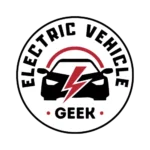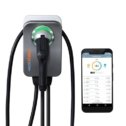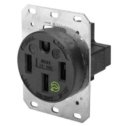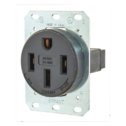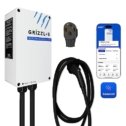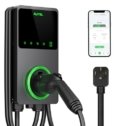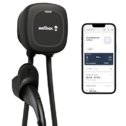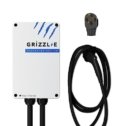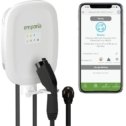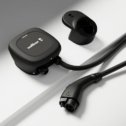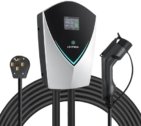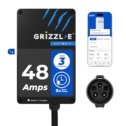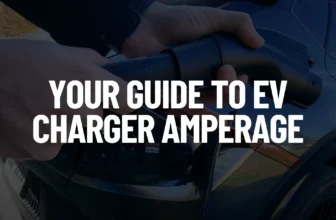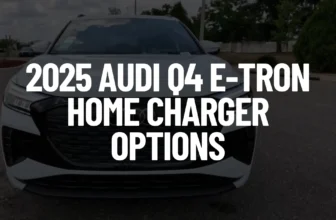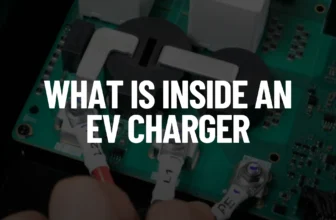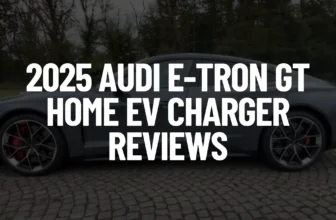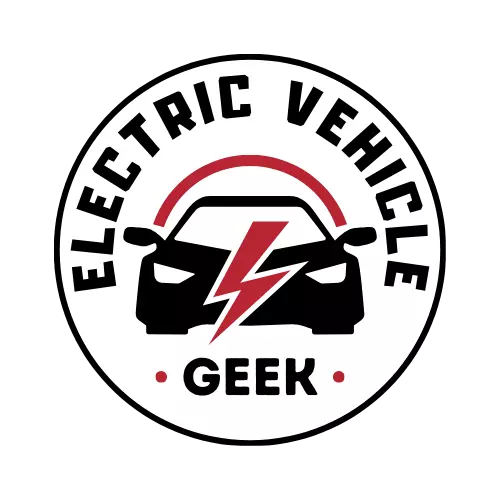We put the ChargePoint Home Flex EV Charger to the test with the Hyundai IONIQ 6 Long Range, evaluating its real-world charging performance, energy efficiency, and overall user experience.
Does this smart Level 2 EV charger live up to its promises when paired with the Hyundai IONIQ 6 Long Range?
Here’s a deep dive into what we discovered.
Table of Contents
- ChargePoint Home Flex Key Specs
- Best EV Charger for Hyundai IONIQ 6 Long Range
- ChargePoint Home Flex Installation for Hyundai IONIQ 6 Long Range
- ChargePoint Home Flex Performance on Hyundai IONIQ 6 Long Range
- Potential Plug-in Alternatives
- Potential Hardwired Alternatives
- Final Verdict – Is It Worth It?
ChargePoint Home Flex Key Specs
Charge Point Home Flex EV Charger Review
- Output: Adjustable Amperage of 16A to 50A (up to 12 kW)
- Connector: J1772 (compatible with Hyundai IONIQ 6)
- Cable Length: 25 feet for flexible placement
- Weatherproof: NEMA 3R rated for safe outdoor and indoor installation
- Amperage Options: Adjustable from 16A to 50A to match your EV’s charging capacity
- Installation Type: Hardwired, or Plug-in (with NEMA 14-50 or NEMA 6-50 outlet)
- Certification: UL-listed and ENERGY STAR certified for safety and efficiency.
- Warranty: 3-year warranty and 24/7 customer support.
Best EV Charger for Hyundai IONIQ 6 Long Range
We recommend the ChargePoint Home Flex hardwired EV charger as the top choice for the Hyundai IONIQ 6 Long Range due to its superior fast charging capabilities compared to the plug-in version. However, if portability is a priority, the ChargePoint Home Flex Plug-in charger is an excellent option for the Hyundai IONIQ 6.
Charge Point Home Flex EV Charger Review
The hardwired ChargePoint Home Flex Level 2 EV charger offers adjustable amperage up to 48A, meeting the IONIQ 6’s maximum onboard charging capacity of 11 kW. When connected to a 240V, 60A circuit, it can fully charge the 77.4 kWh IONIQ 6 Long Range lithium-ion battery in under 7.5 hours.
In comparison, the plug-in ChargePoint Home Flex Level 2 EV charger offers an adjustable amperage of up to 40A, delivering 9.6kW optimized for circuit compatibility and component support, per NEC rules. This is approximately 14.56% lower in power output than the IONIQ 6’s maximum onboard charging capacity of 11kW on a 240V, 60A circuit. As a result, the plug-in charger takes about 1.5 hours longer, fully charging the battery in 9 hours.
| Feature | ChargePoint Home Flex (Hardwired) | ChargePoint Home Flex (Plug-in) |
|---|---|---|
| Amperage | Adjustable up to 48A | Adjustable up to 40A |
| Circuit Requirement | 240V, 60A circuit | 240V, 50A circuit |
| Charging Speed | Up to 11kW | Up to 9.6kW |
| Battery Charge Time (77.4 kWh) | 7.5 hours | 9 hours |
| Installation Type | Hardwired | Plug-in (with NEMA 14-50 or NEMA 6-50 outlet) |
Both chargers deliver reliable performance under continuous 7+ hour loads, maintaining approx 94% to 95% EV charging efficiency, without throttling or significant performance drops. Based on our tests, the main difference is the charging time.
Hyundai’s Trust In ChargePoint Home Flex Level 2 EV Charger
Hyundai’s trust in ChargePoint is evident through their complimentary home charger and charging credit offer, providing a free ChargePoint Home Flex Level 2 EV charger with the purchase or lease of select 2025 IONIQ 5 and IONIQ 6 models.
Hyundai customers can claim the offer through the Hyundai Home Marketplace, where they can arrange delivery and installation and explore solar panels and energy storage options. Installation, taxes, and fees are not included.
Hyundai’s trust in ChargePoint is evident through their complimentary home charger and charging credit offer, offering a free ChargePoint Home Flex Level 2 EV charger with the purchase or lease of select EVs, including the new 2025 IONIQ 5 and IONIQ 6.
Qualifying 2025 IONIQ 5 and IONIQ 6 customers can select the free ChargePoint Home Flex Level 2 EV charger on the Hyundai Home Marketplace where they can also arrange for the delivery and installation of their complimentary Level 2 EV charger, as well as learn about and purchase solar panels and home energy storage systems if they choose.
The free ChargePoint Home Flex Level 2 EV charger requires professional hardwired installation through Hyundai’s approved network. However, installation costs, taxes, and fees are not included. When we inquired about installation, we received a quote of $1,000, though the final price may vary depending on factors such as home layout, fuse box location, and charger placement.
Do we recommend opting for a free complimentary ChargePoint Home Flex Level 2 EV charger?
Yes, the $1,000 installation quote aligns with the typical cost of purchasing and installing the ChargePoint Home Flex through an independent installer. Choosing the complimentary EV charger offer guarantees a high-quality installation by a certified professional, reducing the risk of poor workmanship from uncertified installers. Plus, you get one of the best chargers for the Hyundai IONIQ 6 at no extra cost.
We highly recommend this route, especially if you’re considering solar panels and home energy storage for solar EV charging and also considering the ChargePoint Home Flex as one of the best home solar EV chargers.
Hyundai has partnered with Electrum, combining Hyundai’s electric mobility leadership with Electrum’s expertise in home energy solutions. This Electrum collaboration provides Hyundai customers with access to Electrum’s Energy Advisors, who can guide them through the solar EV charging installation process, address concerns, and ensure a seamless transition to electric driving.
ChargePoint Home Flex Installation for Hyundai IONIQ 6 Long Range
Below, we outline the installation options with circuit wiring diagrams for the ChargePoint Home Flex EV charger for the Hyundai IONIQ 6, whether you choose a hardwired setup or a plug-in option with a NEMA 14-50 or NEMA 6-50 outlet it’s our hope you will find our guide useful.
Hardwired ChargePoint Home Flex Setup for Hyundai IONIQ 6 Long Range
Below is the circuit wiring diagram for a hardwired ChargePoint Home Flex EV charger installed on a 240V, 60A circuit. This setup supports maximum Hyundai IONIQ 6 charging speeds up to 11kW, with the charger’s amperage adjusted to 48 amps based on the NEC’s 80/20 rule for continuous loads.
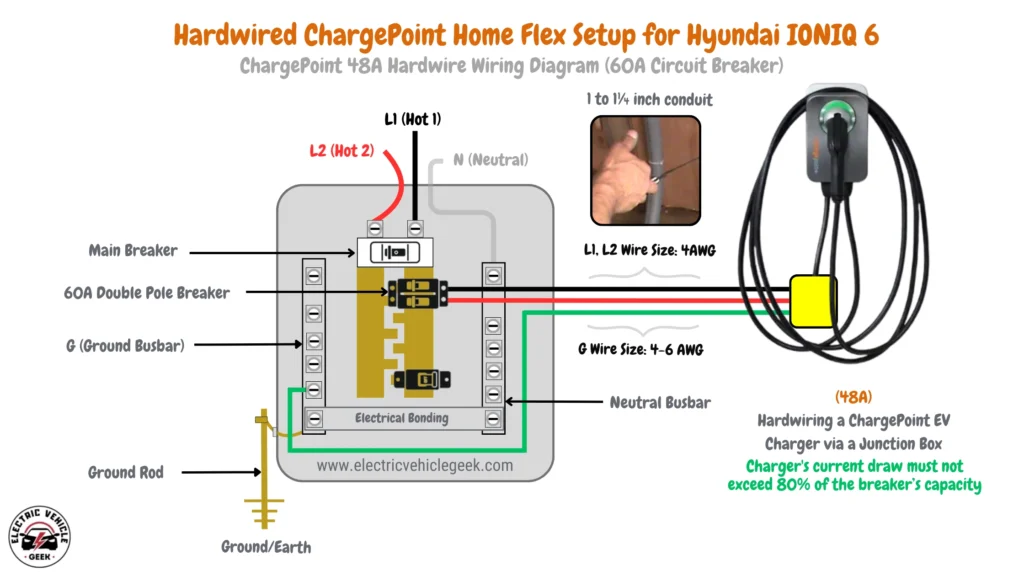
The hardwired ChargePoint Home Flex EV charger circuit wiring diagram above highlights key components of a ChargePoint 48A hardwired installation on a 60A EV charging circuit, including electrical panel wiring for the main breaker, a dedicated 60A double-pole breaker, junction box placement, neutral and ground busbars connection, proper electrical bonding, and EV charger grounding.
The ChargePoint 48A hardwired setup involves running 4 AWG L1 (Hot 1), L2 (Hot 2), neutral, and 4-6 AWG ground wires through a 1 to 1 1/4-inch conduit, ensuring compliance with 48A EV charger wire gauge requirements (4 AWG for L1/L2, 4-6 AWG for ground). A junction box connects the charger’s hardwired input, ensuring the charger’s current draw does not exceed 80% of the circuit’s capacity.
Plug-in ChargePoint Home Flex Installation with NEMA 14-50 for Hyundai IONIQ 6 Long Range
Here is the wiring diagram for the NEMA 14-50 ChargePoint Home Flex EV charger on a 240V, 50A circuit with a NEMA 14-50 outlet. This setup supports charging speeds up to 9.6kW, with the charger’s amperage set to 40 amps according to the NEC’s 80/20 rule for continuous loads.
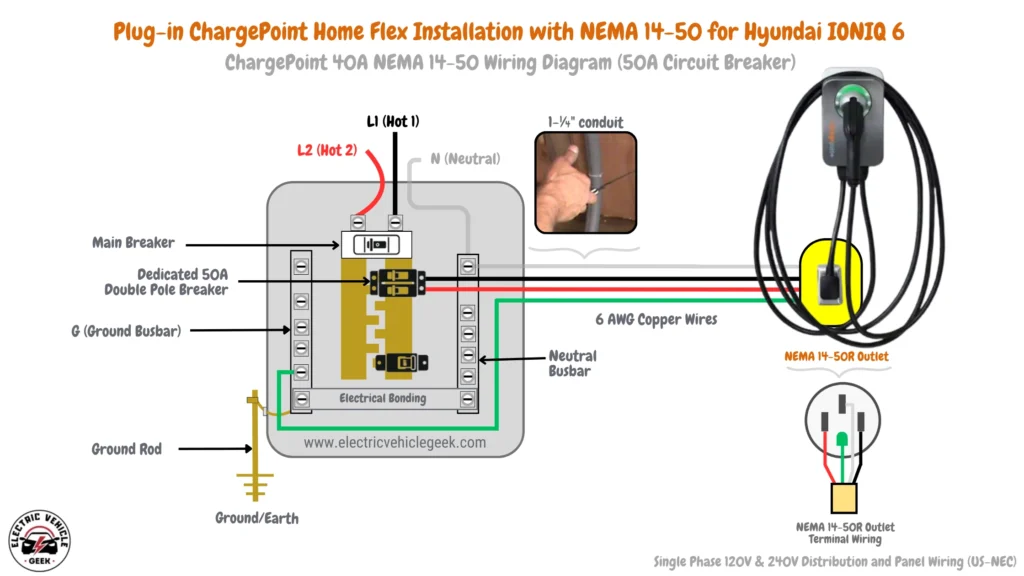
The wiring diagram above provides detailed instructions for installing a 40A ChargePoint Home Flex EV charger using a NEMA 14-50 outlet on a dedicated 50A circuit to achieve maximum charging speed with the Hyundai IONIQ 6. It illustrates key electrical components, including circuit wiring, NEMA 14-50 outlet placement, the main breaker, a dedicated 50A double-pole breaker, neutral and ground busbars, proper electrical bonding, and EV charger grounding.
Wiring instructions specify running 6 AWG solid copper L1 (Hot 1), L2 (Hot 2), neutral, and ground wires from the breaker to the NEMA 14-50R outlet through a 1-1/4 inch conduit. An inset diagram details the correct terminal wiring for the NEMA 14-50R outlet, ensuring a safe and code-compliant installation.
Recommended NEMA 14-50 Outlets
If you’re installing a NEMA 14-50 outlet for your Hyundai IONIQ 6 Long Range, choose one that meets NEC safety standards for 40A continuous charging on a 50A breaker. These outlets support 6 AWG wiring, providing reliable power without overheating or voltage drops.
HBL9450A NEMA 14-50 Receptacle for Level 2 EV Charger Installation (Plug-In)
Bryant 14-50 Outlet for Level 2 EV Charger Installation (Plug-In)
Need help with installation? Check out our step-by-step guide: How to Install NEMA Outlets for EV Charging
Plug-in ChargePoint Home Flex Installation with NEMA 6-50 for Hyundai IONIQ 6 Long Range
This is the wiring diagram for the NEMA 6-50 ChargePoint Home Flex EV charger installed on a 240V, 50A circuit with a NEMA 6-50 outlet. It supports charging speeds up to 9.6kW, with the charger’s amperage adjusted to 40 amps per the NEC’s 80/20 rule for continuous loads.
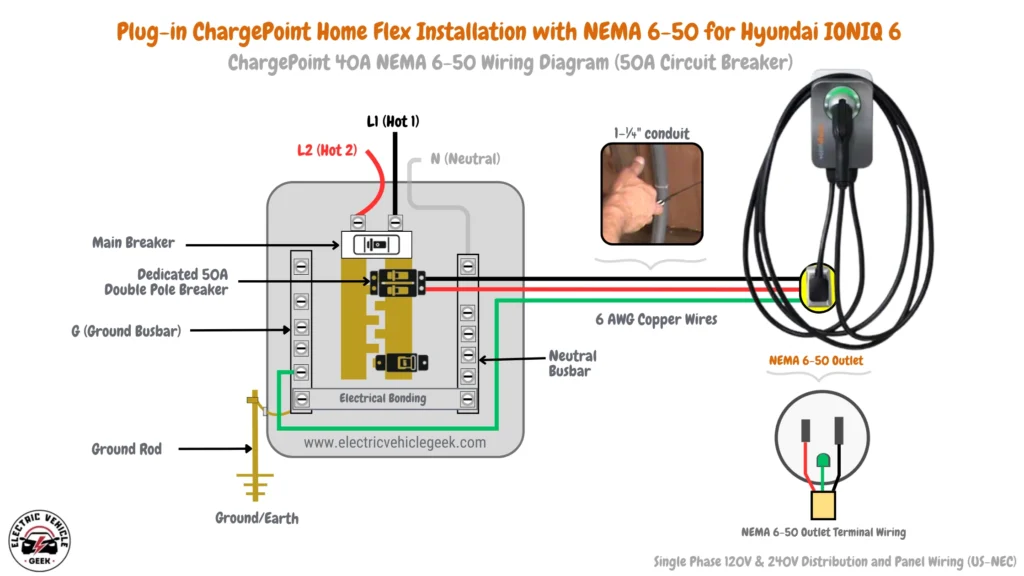
The wiring diagram above provides instructions for installing a ChargePoint Home Flex EV charger using a NEMA 6-50 outlet on a dedicated 50A circuit. It illustrates key electrical components, including EV charger circuit wiring, NEMA 6-50 outlet wiring, the main breaker, a dedicated 50A double-pole breaker, neutral and ground busbars, proper electrical bonding, and EV charging circuit grounding.
The wiring setup includes 6 AWG L1 (Hot 1), L2 (Hot 2), and ground wires running from the breaker to the NEMA 6-50R outlet through a 1-1/4 inch conduit. Since the NEMA 6-50 is a 240V-only outlet, no neutral wire is connected. An inset diagram details the correct NEMA 6-50 terminal wiring, ensuring a safe and compliant installation.
Need installation guidance? Follow our step-by-step tutorial: Hardwired EV Charger Installation Guide
Recommended NEMA 6-50 Outlets
For safe, high-performance charging of the Hyundai IONIQ 6 Long Range, these NEMA 6-50 outlets meet NEC standards for 40A continuous charging on a 50A breaker. Designed to handle 6 AWG wiring, they ensure stable power delivery without overheating, voltage drops, or risk of melting. Perfect for use with the ChargePoint Home Flex at up to 40A.
Hubbell NEMA 6-50R Outlet for Level 2 EV Charger Installation (Plug-In)
Bryant NEMA 6-50R Outlet for Level 2 EV Charger Installation (Plug-In)
Need installation guidance? Follow our detailed tutorial: How to Install NEMA Outlets for EV Charging
ChargePoint Home Flex Performance on Hyundai IONIQ 6 Long Range
To evaluate the real-world charging performance of the ChargePoint Home Flex, we conducted a 28-day test using a rented Hyundai IONIQ 6 Long Range (EPA-estimated 342-mile range).
Our analysis included the use of professional tools such as the Autel MaxiSys Ultra EV OBD2 Scanner for onboard battery diagnostics, the ChargePoint Mobile App for energy consumption monitoring, distance tracking, and setting reminders, and an independent meter-based system for measuring energy delivery to the circuit, monitoring efficiency, and verifying billing accuracy.
Our daily driving varied between 150 and 250 miles, except on the first and last days when we drove 50 miles to pick up and return the vehicle. Thanks to its long range, the IONIQ 6 proved ideal for our test, allowing us to drive confidently without experiencing EV charging range anxiety.
For the first 14 days, we used the hardwired 48-amp ChargePoint Home Flex, followed by another 14 days with the 40-amp plug-in version.
The table below outlines each day’s charging durations for each setup and the miles we covered:
| Day | Miles Traveled | ChargePoint Home Flex 48A (Hours Charging) | ChargePoint Home Flex 40A (Hours Charging) |
|---|---|---|---|
| 1 | 50 | 2.0 | 2.0 |
| 2 | 150 | 2.5 | 4.0 |
| 3 | 200 | 4.5 | 5.0 |
| 4 | 150 | 4.0 | 4.0 |
| 5 | 250 | 5.0 | 6.5 |
| 6 | 200 | 4.5 | 4.5 |
| 7 | 200 | 4.5 | 5.5 |
| 8 | 200 | 5.0 | 5 |
| 9 | 200 | 4.5 | 4.5 |
| 10 | 150 | 3.0 | 5 |
| 11 | 200 | 4.0 | 4 |
| 12 | 150 | 4.0 | 4 |
| 13 | 200 | 4.5 | 5 |
| 14 | 50 | returned without charging | returned without charging |
ChargePoint Home Flex (Hardwired) Performance
For the first 14 days, we paired the IONIQ 6’s 77.4 kWh battery with the hardwired ChargePoint Home Flex 48A, utilizing an 11 kW onboard charger on a NEMA 14-50 circuit. Following the 80/20 charging rule (keeping the EV battery between 20% and 80% SoC), the 48A unit provided fast, consistent power, making overnight charging seamless.
The chart below visualizes the 14-day charging and discharging patterns, providing key insights into the IONIQ 6’s State of Charge (SoC) performance and charging behavior.
As shown in the 14-day charging and discharging patterns chart above, although the IONIQ 6 has built-in battery preconditioning features, we also used a traditional method by charging the EV immediately after driving. This helped precondition the battery, reducing charge time and improving charging rate and efficiency.
Charging patterns showed predictable SoC reductions of approximately 45.1% for 150-mile trips and 60.1% for 200-mile trips. Our hardwired circuit recorded 95% EV charging efficiency with charging times ranging from 2.5 to 5.0 hours, with longer sessions for deeper discharges.
The energy delivered vs. charging time chart below, based on our test results, demonstrates a stable energy transfer rate with minimal throttling and we never experienced EV charging voltage drops.
The hardwired 48A ChargePoint Home Flex proved to be an efficient and reliable home charging solution, minimizing downtime for daily long-range commutes.
ChargePoint Home Flex (Plug-in) Performance
For the next 14 days, we switched to the plug-in ChargePoint Home Flex 40A (9.6 kW). This test assessed its charging speed, energy efficiency, and practicality compared to the 48A hardwired version.
Following the same 80/20 EV charging strategy, SoC reductions ranged from 15.0% (50 miles) to 75.1% (250 miles) per day.
Our plug-in circuit achieved 94% EV charging efficiency, with charging times ranging from 2.0 to 6.5 hours. It replenished between 18.2 kWh and 59.3 kWh daily without overheating any component of the circuit, including the cables, outlet, or charger.
Compared to the 48A model, the 40A plug-in version required longer charge times:
- Over the 14 days, the total additional charging time was approximately 7.0 hours.
- Each session took 30-40% longer than the 48A version.
- The most significant single-day difference was +2.0 hours, while typical differences ranged from 0.5 to 1.5 hours per charge.
While the 40A plug-in version remained effective for home charging, users requiring faster turnaround for high-mileage daily driving may benefit from the hardwired 48A unit.
Potential Plug-in Alternatives
Looking for a portable plug-in EV charger alternative to the ChargePoint Home Flex for your Hyundai IONIQ 6 Long Range?
The Grizzl-E Smart is a budget-friendly smart EV charger, while the Autel AC Elite offers enhanced security features, including optional RFID card start/stop functionality. The Wallbox Pulsar Plus 40A provides a compact, smart charging solution, while the Grizzl-E Classic delivers a rugged, high-power alternative without smart features—ideal for those who prefer simplicity and reliability.
Grizzl-E Smart EV Charger Review Best seller
Autel AC Elite In-Body Holster EV Charger Review
Wallbox Pulsar Plus 40-Amp EV Charger Review
Grizzl-E Classic EV Charger Review
Plug-in chargers are perfect for renters or future-proofing, allowing easy relocation while still delivering optimal charging speeds for your IONIQ 6.
Potential Hardwired Alternatives
If you’re looking for a hardwired EV charger that delivers the same high-performance charging as the 48A ChargePoint Home Flex, consider these top-rated alternatives.
The Emporia EV Charger delivers 48A charging with smart Wi-Fi controls, while the Wallbox Pulsar Plus 48A offers a compact design and Bluetooth connectivity. For those who prefer rugged, durable options, the Grizzl-E 48A Ultimate is a UL-certified, heavy-duty choice.
Emporia EV Charger Review
Wallbox Pulsar Plus 48-Amp EV Charger Review
Lectron V-Box 48 EV Charger Review
Grizzl-E 48A Ultimate EV Charger Review
Hardwired installation ensures a secure, permanent charging setup with efficient power delivery—ideal for maximizing IONIQ 6 charging speeds.
Final Verdict – Is It Worth It?
Yes, For Hyundai IONIQ 6 Long Range owners, the ChargePoint Home Flex stands out as one of the best home EV charging solutions.
The ChargePoint Home Flex 48A significantly outperformed the 40A version in terms of charging speed, making it the better choice for long-range EV users seeking minimal downtime. However, for users with moderate daily mileage or those without the ability to hardwire a charger, the 40A plug-in version remains a solid, reliable alternative.
Hyundai’s partnership with ChargePoint further strengthens its credibility, offering a complimentary ChargePoint Home Flex with select 2025 IONIQ 5 and IONIQ 6 models. While installation costs aren’t covered, the estimated $1,000 fee aligns with market rates for professional installation.
Ultimately, if you’re investing in solar EV charging, the ChargePoint Home Flex is one of the best home solar EV chargers, seamlessly integrating with home energy solutions. Given its efficiency, reliability, and Hyundai’s endorsement, it’s a highly recommended charger for IONIQ 6 Long Range owners.
Have you used the ChargePoint Home Flex to charge your Hyundai IONIQ 6 Long Range?
Did it deliver the charging speed and convenience you expected? Let us know your thoughts in the comments below—and don’t forget to mention whether you own the hardwired or plug-in version!

James Ndungu is a certified EV charger installer with over five years of experience in EVSE selection, permitting, and installation. He holds advanced credentials, including certification from the Electric Vehicle Infrastructure Training Program (EVITP) and specialized training in EV charging equipment and installation, as well as diplomas in EV Technology and Engineering Fundamentals of EVs. Since 2021, James has tested dozens of EV chargers and accessories, sharing expert insights into the latest EV charging technologies.
